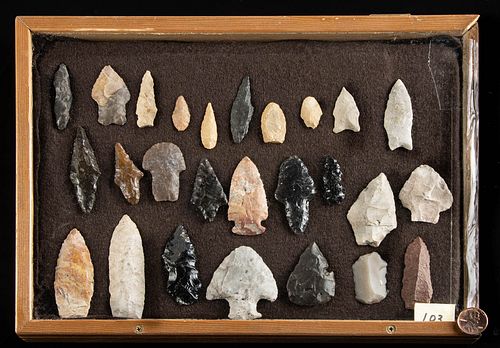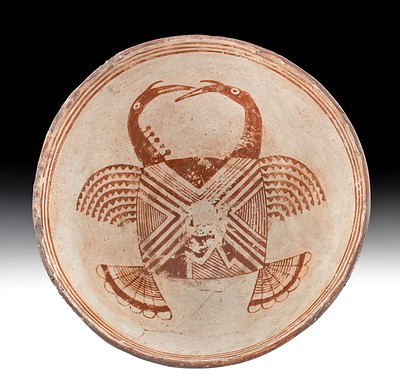26 Native American & Near Eastern Stone Tools
Lot 61
About Seller
Artemis Gallery
686 S Taylor Ave, Ste 106
Louisville, CO 80027
United States
Selling antiquities, ancient and ethnographic art online since 1993, Artemis Gallery specializes in Classical Antiquities (Egyptian, Greek, Roman, Near Eastern), Asian, Pre-Columbian, African / Tribal / Oceanographic art. Our extensive inventory includes pottery, stone, metal, wood, glass and textil...Read more
Categories
Estimate:
$600 - $900
Absentee vs Live bid
Two ways to bid:
- Leave a max absentee bid and the platform will bid on your behalf up to your maximum bid during the live auction.
- Bid live during the auction and your bids will be submitted real-time to the auctioneer.
Bid Increments
| Price | Bid Increment |
|---|---|
| $0 | $25 |
| $300 | $50 |
| $1,000 | $100 |
| $2,000 | $250 |
| $5,000 | $500 |
| $10,000 | $1,000 |
| $20,000 | $2,500 |
| $50,000 | $5,000 |
| $100,000 | $10,000 |
| $200,000 | $20,000 |
About Auction
By Artemis Gallery
Apr 22, 2021
Set Reminder
2021-04-22 12:00:00
2021-04-22 12:00:00
America/New_York
Bidsquare
Bidsquare : Art & Artifacts of North America
https://www.bidsquare.com/auctions/artemis-gallery/art-artifacts-of-north-america-6851
Join us for a special auction featuring an important collection of Native American points and artifacts from Charlie Meyers, famed illustrator for Greg Perino. Artemis Gallery info@artemisgallery.com
Join us for a special auction featuring an important collection of Native American points and artifacts from Charlie Meyers, famed illustrator for Greg Perino. Artemis Gallery info@artemisgallery.com
- Lot Description
Native American, California, Arkansas, Texas, New Mexico, Indiana, Florida, Nevada, Illinois, Iowa, Missouri, Transitional Paleo Indian to Late Prehistoric Period, ca. 9000 BCE to 1300 CE (11,000 to 700 BP); Near East, Libya, ca. 10000 to 2000 BCE (12,000 to 4,000 BP); South Yemen, Wadi Harib, ca. 6000 to 5000 BCE (8,000 to 7,000 BP); South America, Argentina, ca. 10900 to 10300 BCE (12,900 to 12,300 BP); Brazil, Rio Grande do Sul, ca. 9000 BCE to 1400 CE (11,000 to 600 BP). A spectacular ensemble of hand-knapped stone tools - 23 projectile points, 2 blades, and 1 end knife - some boasting lustrous shades of chocolate brown, charcoal grey, and black, while others showcase matte hues of maroon, caramel, butterscotch, ash grey, taupe, peach, apricot, misty rose, and cream. Formed from stones like obsidian, quartz, and chert, the ancient arrowheads present a wide variety of forms, including ovoid, stemmed, contracting stem, triangular side notch, ovate stemmed, lanceolate contracting stem, triangular stemmed, and triangular corner notch. The projectile points that are identifiable are classified as Chumash, Morril, Meadowood, Silver Lake, Sumter, Lone Tree, Karnak, Jay, and Snyder. Size of largest: 1" W x 2.875" H (2.5 cm x 7.3 cm); Size of frame: 12" W x 8.75" H (30.5 cm x 22.2 cm)
Provenance: private Fayetteville, Arkansas, USA collection; ex-Charles (Charlie) Meyer collection, noted collector and famed illustrator for Greg Perino, famed authenticator and writer
All items legal to buy/sell under U.S. Statute covering cultural patrimony Code 2600, CHAPTER 14, and are guaranteed to be as described or your money back.
A Certificate of Authenticity will accompany all winning bids.
We ship worldwide and handle all shipping in-house for your convenience.
#163443Minor losses, as well as some nicks or chips to peripheries, commensurate with age and use. Otherwise, very nice. Set in wood and glass frame. Right side of frame missing.Condition
- Shipping Info
-
All shipping is handled in-house for your convenience. Your invoice from Artemis Gallery will include shipping calculation instructions. If in doubt, please inquire BEFORE bidding for estimated shipping costs for individual items.
-
- Buyer's Premium



 EUR
EUR CAD
CAD AUD
AUD GBP
GBP MXN
MXN HKD
HKD CNY
CNY MYR
MYR SEK
SEK SGD
SGD CHF
CHF THB
THB












